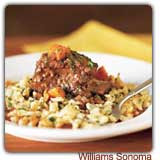Test your wine knowledge! Answer this week's question: What is the second most planted white wine grape in California? (answer at end)
WEEK #5 WINE CLASS:Versatile and responsive to the winemaker's touch, the Chardonnay grape is the most planted world-wide, as it is easier to grow than most and can tolerate a wide range of soils and climates. Chardonnay wines range from agreeable jug wines produced from abundant vines to the finest wines brought to perfection by careful hand-thinning and labor intensive vinification. Three of the subregions in France's famed Burgundy AOC produce extraordinary wines from the grape: Côte de Beaune, Chablis and Mâconnais. But, Chardonnay from California has been steadily gaining world-wide acclaim and for good reason. The grape was our focus this week in class and our tasting was especially interesting because we had four wines to compare, instead of the usual two: a value Chardonnay from the Central Valley, two French white Burgundies, and a Sonoma Coast AVA Chardonnay.
- 2008 Fevre Estate from Chablis is made by Bouchard Père et Fils with hand-harvested grapes. Wine Spectator gave this wine 90 points. It had the hallmark acidity and green apple flavor of French Chablis with minerality and a taste of wet stone.
- The 2008 Christophe Cordier Macon-Charnay "Vieilles Vignes" from Mâconnais was also brightly acidic with a strong vanilla oaked flavor, plus peachy fruit.
- The 2009 McManis Chardonnay is a $10 bottle of wine with "California" rather than vineyard-designated grapes, and without the intensity of the other more expensive wines, but a reasonable expression of the varietal, creamy from maloactic fermentation. Made by a family owned winery.
- The class loved the 2008 Fog Dog that I brought for us to try, from the Touring and Tasting's cellar. (Insider note: Touring and Tasting has a "secret cellar" of wines not in the online store plus can often procure a wine you request. So call Shannon at (800) 850-4370 ext. 100 if you're interested!) The Fog Dog displayed everything that makes (in my mind) California wine so superior. It's not just patriotism--grapes find their fullest ripeness under the California sun. The resulting fruit balances the acidity that develops from coastal fogs. The Fog Dog Chardonnay is from artisanal, biodynamically farmed Freestone Winery in the Sonoma Coast AVA, on the border of the Russian River. The wine was big, buttery and perfectly balanced with a long silken finish and aroma of honeysuckle.
Similar in DNA profile to Pinot Noir, the Pinot Gris grape is called Pinot Grigio in Italy and California, and can range in style from the big, full-flavored, full bodied wines from Alsace, France to the lighter bodied, crisp wines from coastal California, often redolent with citrus. Pinot Gris can be vinified, bottled and on the shelf ready to drink in just a month to 3 months.
Answer to our wine question: According to the latest USDA National Agricultural Statistics Service report, in 2009 90,434 acres of California farmland was planted to Chardonnay for winemaking, 24,772 to Colombard, 14,670 to Sauvignon Blanc, 8,676 to Pinot Gris.
What is Colombard? It is an easy-to-grow grape, mostly impervious to problems like rot. It develops fruit in abundance, producing up to 10 tons an acre (compared to some grapes that are kept below 1 ton per acre to maximize quality and flavor). It is used to give structure and a citrus flavor and aroma to "jug wines": simple, inexpensive wines often sold in boxes or large bottles.





















